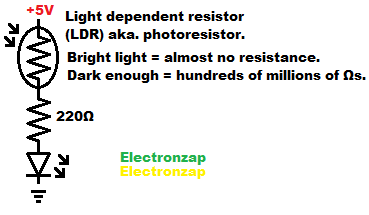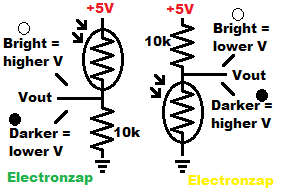Table of Contents
The Light Dependent Resistor (LDR), sometimes called a photoresistor, provides a resistance that is mostly based on the amount of light falling on it.

LDR used as a current limiting resistor:
You can use a LDR in series with other components to allow a lot of current (low resistance) to flow through them when there is bright light falling on the LDR.
Whereas, low to no light falling on the LDR will eliminate almost all current flow through series components. Thus, the LDR is providing a high amount of resistance under low light.
If it is dark enough, then virtually all current ceases to flow through the LDR and series components. The LDR has many millions of ohms of resistance without light falling on it.
If the light is falling on the LDR is bright enough, then it is likely that it’s resistance will be too low for the circuit on it’s own. So, it is best to ad a series resistor that has a value that will provide the minimum resistance that the circuit needs. The LDR and fixed value resistances will add simply up as far as the series circuit is concerned.
Limiting Max. and or Minimum LDR controlled resistance:

- Total resistance can never be lower than the value of a fixed value resistance that is in series with the LDR. No matter how bright of a light falls on the LDR.
- Total resistance can never be higher than the value of a fixed value resistance that is in parallel with the LDR. Even if the LDR is in complete darkness.
- Adding a series and a parallel resistance to the LDR, will set both a maximum and minim resistance that will be provided to other series components.
LDR Voltage divider:

You will probably see a LDR used as a voltage divider more than anything else. It is in series with a fixed resistor, but other circuitry is monitoring the voltage that is between them (Output voltage, or Vout for short).
- High side LDR voltage divider is when the LDR is connected to the more positive voltage in relationship to the fixed value resistor.
- Bright light makes the LDR conduct better, so the divided voltage will be closer to the positive supply voltage.
- Little to no light makes the LDR conduct little if at all. Making it so the fixed resistor connected to ground, pulls the output voltage closer to ground.
- Low side LDR voltage divider has the LDR connected to ground while fixed resistor is connected to power supply.
- Vout goes down as more light falls on LDR.
- Vout goes up as less light falls on LDR.
Smoothing a rapidly changing LDR voltage:
A capacitor can be used to provide a relatively smooth average voltage coming from a rapidly changing voltage. Such as when there is a quickly pulsing (ie. PWM) LED light hitting a Light Dependent Resistor (LDR) that is part of a voltage divider circuit.

Related pages:
–– –– – Light Dependent Resistor –
To support this site, check out the following links:
- Become a Patron!
- Check out my YouTube videos! https://www.youtube.com/c/Electronzap/videos
- Products I used in my videos or otherwise think look like a good buy. As an Amazon associate, I earn from qualifying purchases. My Amazon affiliate page showing products I think look good
- Information on this site is not guaranteed to be accurate. Always consult the manufacturer info/datasheet of parts you use. Research the proper safety precautions for everything you do.
- Electronzap is a participant in the Amazon Services LLC Associates Program, an affiliate advertising program designed to provide a means for sites to earn advertising fees by advertising and linking to amazon.com.